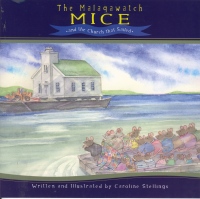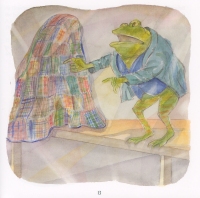| ________________
CM . . .
. Volume XI Number 20 . . . . June 10, 2005
excerpt:
Preserving our past in words is a valiant task for any writer, but it is especially so when the intended audience is young children and the chosen form is the picture storybook. Caroline Stellings in The Malaqawatch Mice and the Church That Sailed has undertaken this very task. In the small Cape Breton community of Malaqawatch, a church that had been in existence for 130 years found itself without sufficient members of its congregation to support it. There had been a church at Malaqawatch since 1724 when it was originally built as a mission church for the Mi'kmaq. A hundred years later, there was a Scots Presbyterian church built on the spot which carried on into the twentieth century eventually joining the United Church of Canada in 1925. It was a history worth preserving. In 2003, the congregation agreed to sell the church to the Highland Village Museum at Iona in an attempt to preserve this heritage. To get to Iona, the church needed to be sailed by barge 20 kilometres across the Bras d'Or Lake.
The reader is quickly caught up in the plight of these pleasant human like mice. The story is written as a poem which adds to the sense of character about the book. Even though at times, the cadence or the end rhyme is a little forced, the reader gets a sense of Scottish lilt to the tale. Young readers will readily identify with these small creatures and the other forest creatures (rabbits, squirrels, frogs and shrews) that are found throughout the story. Stellings' beautiful watercolour illustrations add to the characterization of the mice and their friends. The reader is drawn not only to the sorrow and despair felt by the mice as they watch their beloved church sail away but also to the triumph felt in the two page illustration depicting the church being towed on its barge followed by the mice's barge with its highland sail. The dreamlike quality of the watercolours works particularly well at linking two stories - the reality of moving a church with the fantasy of the mice. At the end of this marvelous story, Stellings included a short historical summary of the history of the Malaqawatch Church which firmly grounds this little known story in Canadian history. While the story would be of particular interest to the Cape Breton area, it is not a book without interest to the rest of Canada. This reviewer is struck by the possibility of historical comparison with the resettlement program undertaken in Newfoundland during the 1960s through which many communities were floated to new townsites. Similar stories may exist elsewhere in Canada. Children anywhere would be drawn to the fantastic nature of the idea of floating buildings. As historical fiction for young readers is difficult to find, especially historical fiction with a Canadian slant, this is a book worth having in your collection. Hopefully, it will inspire other writers and illustrators to try their hand at helping to instill a sense of pride through the learning of our history amongst the youngest readers. Highly Recommended. Gillian Martin Noonan is an elementary teacher living in Old Perlican, NL.
To comment
on this title or this review, send mail to cm@umanitoba.ca.
Copyright © the Manitoba Library Association. Reproduction for personal
use is permitted only if this copyright notice is maintained. Any
other reproduction is prohibited without permission.
NEXT REVIEW
|TABLE OF CONTENTS FOR THIS ISSUE
- June 10, 2005.
AUTHORS
| TITLES | MEDIA REVIEWS
| PROFILES
| BACK ISSUES
| SEARCH | CMARCHIVE
| HOME |

 Just the act of sailing a building is noteworthy enough without the added historical significance of
the said building. But how to present that history to the very young without boring them with
details? Stellings found the answer very cleverly. Instead of telling the story from the point of
view of the human congregation, Stellings invents a mice congregation that inhabits the church's
basement in a very human way. Just like the people in the church, these mice could trace their
history to Scotland and even had a tangible reminder (a quilt made of the tartans of each Scottish
clan) of their heritage. When the mice realize that the church is to be moved, they quickly realize
that they wish to move as well and set about raising money to pay for the move through rummage
sales and doing odd jobs. Alas, the efforts of the mice fall short, and the church move begins
before they are ready. Quick thinking and the use of that ancient quilt as a sail save the day, and
the mice are not left behind. Hurrah!
Just the act of sailing a building is noteworthy enough without the added historical significance of
the said building. But how to present that history to the very young without boring them with
details? Stellings found the answer very cleverly. Instead of telling the story from the point of
view of the human congregation, Stellings invents a mice congregation that inhabits the church's
basement in a very human way. Just like the people in the church, these mice could trace their
history to Scotland and even had a tangible reminder (a quilt made of the tartans of each Scottish
clan) of their heritage. When the mice realize that the church is to be moved, they quickly realize
that they wish to move as well and set about raising money to pay for the move through rummage
sales and doing odd jobs. Alas, the efforts of the mice fall short, and the church move begins
before they are ready. Quick thinking and the use of that ancient quilt as a sail save the day, and
the mice are not left behind. Hurrah!